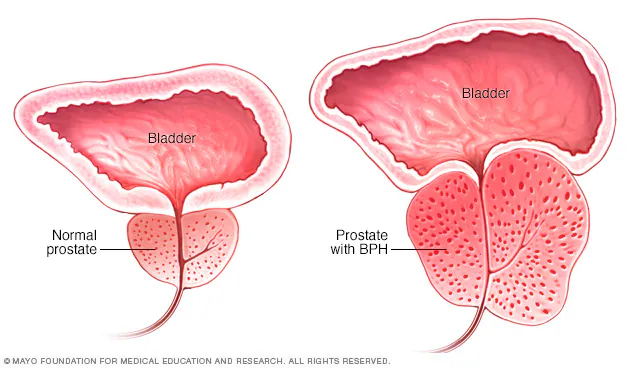Prostate Surgery / TURP
Prostate Surgery / TURP
A transurethral resection of the prostate (TURP) is a surgical procedure that involves cutting away a section of the prostate. The prostate is a small gland in the pelvis only found in men. It’s located between the penis and bladder, and surrounds the urethra (the tube that carries urine from the bladder to the penis).
If the prostate becomes enlarged, it can place pressure on the bladder and urethra. This can cause symptoms such as having difficulty peeing.
Transurethral resection of the prostate (TURP) is a surgery used to treat urinary problems that are caused by an enlarged prostate. An instrument called a resectoscope is inserted through the tip of your penis and into the tube that carries urine from your bladder (urethra)..

Why TURP is Carried Out
TURP helps reduce urinary symptoms caused by benign prostatic hyperplasia (BPH), including:
- Frequent, urgent need to urinate
- Difficulty starting urination
- Slow (prolonged) urination
- Increased frequency of urination at night
- Stopping and starting again while urinating
- The feeling you can’t completely empty your bladder
- Urinary tract infections
TURP might also be done to treat or prevent complications due to blocked urine flow, such as:
- Recurring urinary tract infections
- Kidney or bladder damage
- Inability to control urination or an inability to urinate at all
- Bladder stones
- Blood in your urine
What Are The Risks
Risks of TURP can include:
- Temporary difficulty urinating. You might have trouble urinating for a few days after the procedure. Until you can urinate on your own, you will need to have a tube (catheter) inserted into your penis to carry urine out of your bladder.
- Urinary tract infection. This type of infection is a possible complication after any prostate procedure. An infection is increasingly likely to occur the longer you have a catheter in place. Some men who have TURP have recurring urinary tract infections.
- Dry orgasm. A common and long-term effect of any type of prostate surgery is the release of semen during ejaculation into the bladder rather than out of the penis. Also known as retrograde ejaculation, dry orgasm isn’t harmful and generally doesn’t affect sexual pleasure. But it can interfere with your ability to father a child.
- Erectile dysfunction. The risk is very small, but erectile dysfunction can occur after prostate treatments.
- Heavy bleeding. Very rarely, men lose enough blood during TURP to require a blood transfusion. Men with larger prostates appear to be at higher risk of significant blood loss.
- Difficulty holding urine. Rarely, loss of bladder control (incontinence) is a long-term complication of TURP.
- Low sodium in the blood. Rarely, the body absorbs too much of the fluid used to wash the surgery area during TURP. This condition, known as TURP syndrome or transurethral resection (TUR) syndrome, can be life-threatening if untreated. A technique called bipolar TURP eliminates the risk of this condition.
- Need for re-treatment. Some men require follow-up treatment after TURP because symptoms don’t improve or they return over time. Sometimes, re-treatment is needed because TURP causes narrowing (stricture) of the urethra or the bladder neck.
How You Prepare
Several days before surgery, your doctor might recommend that you stop taking medications that increase your risk of bleeding, including:
- Blood thinners such as warfarin (Coumadin, Jantoven) or clopidogrel (Plavix)
- Nonprescription pain relievers such as aspirin, ibuprofen (Advil, Motrin IB, others) or naproxen sodium (Aleve, others)
Your doctor may prescribe an antibiotic to prevent urinary tract infection.
Arrange transportation because you won’t be able to drive yourself home after the procedure that day or generally if you have a catheter in your bladder.
You might not be able to work or do strenuous activity for up to six weeks after surgery. Ask your doctor how much recovery time you might need.